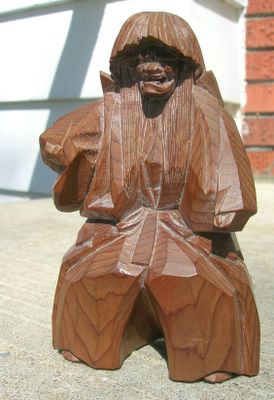Does anybody know what this statue is? I thought it was one of the Japanese Noh Theatre characters, Hannya however I don’t see horns growing out of her forehead as is traditional for this character. The statue is a simple carved wood one measuring about 4 inches in height. The hair which shades her eyes falls down the back ending in a point. There is a mixture of fine detail and simple single stroke cuts after the style of Enko. (Enko was a 17th century Zen Buddhist monk who carved with a hatchet and left behind an incredible legacy of carved Buddhas.)


It’s quite interesting. The gi and stance make me think Karate, but the grimace and the arm position seem more theatrical. I wonder if she (he?) is a character from a play or story?
M
Hi Reverend Mugo
Thought you might find this photo fun since it is a modern Japanese sculptor, quite a bit different than the sculpture you have on your blog!
http://cfapp2.rockymountainnews.com/slideshow/slideshow.cfm?type=WORLD&ID=042706world&NUM=8
All the best to you…Jack
Rev. Mugo I belive your on the right track, but I have also seen this character depicted in Kabuki theater also, and without the horns. Here is a clip from an article about the Kabuki dnace this figure appears in….
The theme of “Renjishi” stays close to that of the Nô play “Shakkyô”, and it is classified as a matsubame dance. That is, a dance that’s performed before the symbolic backdrop of a large pine tree flanked by bamboo which is copied from the Nô stage. This scenery has no connection with the dance’s content. The first section features a pair of Kyôgen actors who come to dance the story of the shishi parent and cub. The actors each carry a wooden mask of a shishi head, one with white hair representing the parent shishi and the other with red hair to represent its child. A shishi is a mythological lion-like animal said to be the king of beasts and always associated with the Buddhist deity Monju. For this reason, any portrayal of the shishi should not only bring out its wild, beastial nature, but also a sense of dignity and authority that goes with this divine status. The shishi is in many ways a spiritual creature.
Thanks very much for the input. Now I must return to the person who gave this to the Priory. I’ll post anything I find out in this comment section. I’ve grown rather fond of this little figure.
The statue is a “one-knife” carving bought about 37 years ago in Takayama. It depicts a Noh player doing a lion dance. The comments by Johnny Newt seem to be correct.
This comment contributed by the donor of the statue.
Many thanks all.